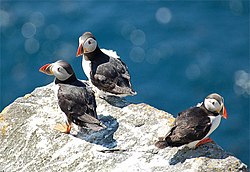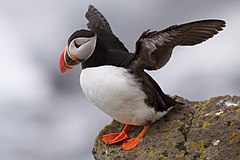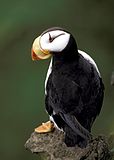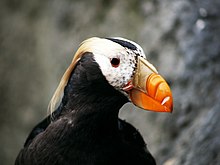Puffin
| Puffin | |
|---|---|

| |
| Atlantic Puffins (F. arctica) | |
| Scientific classification | |
| Kingdom: | |
| Phylum: | |
| Class: | |
| Order: | |
| Family: | |
| Genus: | Fratercula Brisson, 1760
|
| Species | |
|
For prehistoric species, see article text. | |
Puffins are any of three small species of auk (or alcids) in the bird genus Fratercula with a brightly coloured beak during the breeding season. These are pelagic seabirds that feed primarily by diving in the water. They breed in large colonies on coastal cliffs or offshore islands, nesting in crevices among rocks or in burrows in the soil. Two species, the Tufted Puffin and Horned Puffin, are found in the North Pacific Ocean, while the Atlantic Puffin is found in the North Atlantic Ocean.
All puffin species have predominantly black or black and white plumage, a stocky build, and large beaks. They shed the colourful outer parts of their bills after the breeding season, leaving a smaller and duller beak. Their short wings are adapted for swimming with a flying technique under water. In the air, they beat their wings rapidly (up to 400 times per minute)[1] in swift flight, often flying low over the ocean's surface.
Taxonomy
The Rhinoceros Auklet (Cerorhinca monocerata) has sometimes been included in the genus Fratercula,[2] and some authors place the Tufted Puffin in the genus Lunda.[3] The puffins and the Rhinoceros Auklet are closely related, together composing the subfamily Fraterculini.[4]
The genus name Fratercula is derived from Latin and means "little brother", a reference to the black and white plumage, which resembles monastic robes. The English name "puffin" was originally applied to the Manx Shearwater which (in 1652) was known as the "Manks Puffin". Puffin is an Anglo-Norman word (Middle English pophyn or poffin)[5] for the cured carcasses of nestling Manx Shearwaters. The Atlantic Puffin acquired the name much later, possibly because of its similar nesting habits.[6] The name has been applied to the related Razorbill in Ireland.[5]
The oldest alcid fossil is Hydrotherikornis from Oregon dating to the Late Eocene while fossils of Aethia and Uria go back to the Late Miocene. Molecular clocks have been used to suggest an origin in the Pacific in the Paleocene.[7] Fossils from North Carolina were originally thought to have been of two Fratercula species,[8] but were later reassigned to one Fratercula, the Tufted Puffin, and a Cerorhinca species.[9] Another extinct species, Dow's Puffin (Fratercula dowi) was found on the Channel Islands of California until the Late Pleistocene or early Holocene.[4]
The Fraterculini are thought to have originated in the Pacific primarily because of their greater diversity there; there is only one extant species in the Atlantic, compared to two in the Pacific. The Fraterculini fossil record in the Pacific extends at least as far back as the middle Miocene, with three fossil species of Cerorhinca, and material tentatively referred to that genus, in the middle Miocene to late Pliocene of southern California and northern Mexico. Although there no records from the Miocene in the Atlantic, a re-examination of the North Carolina material indicated that the diversity of puffins in the early Pliocene was as great in the Atlantic as it is in the Pacific today. This diversity was achieved through influxes of puffins from the Pacific; the later loss of species was due to major oceanographic changes in the late Pliocene due to closure of the Panamanian Seaway and the onset of severe glacial cycles in the North Atlantic.[9]
Description
The puffins are stocky, short-winged and short-tailed birds, with black upper parts and white or brownish-grey underparts. The head has a black cap, the face is mainly white, and the feet are orange-red. The bill appears large and colourful during the breeding season. The colourful outer part of the bill is shed after the breeding season, revealing a smaller and duller true bill beneath.[10]
Although the puffins are vocal at their breeding colonies, they are silent at sea.[11] They fly relatively high above the water, typically 10 m (30 ft) as compared with the 1.6 m (5 ft) of other auks.[11]
Species details
| Species in taxonomic sequence | |||
|---|---|---|---|
| Common and binomial names | Image | Description | Range |
| Atlantic Puffin (Fratercula arctica) |
 |
32 cm (12.5 in) long, with a 53 cm (21 in) wingspan, weight 380 g (13 oz).[11] | North Atlantic: coasts of northern Europe south to northern France, the British Isles, the Faroe Islands, Iceland, Greenland, Norway and Atlantic Canada then south to Maine. Winters south to Morocco and New York[12] |
| Horned Puffin (Fratercula corniculata) |
 |
38 cm (15 in) long, with a 58 cm (23 in) wingspan, weight 620 g (1.4 lb).[11] | North Pacific: coasts of Siberia, Alaska and British Columbia, wintering south to California and Baja California[13] |
| Tufted Puffin or Crested Puffin (Fratercula cirrhata) |
 |
38 cm (15 in) long, with a 63.5 cm (25 in) wingspan, weight 780 g (1.7 lb).[11] | North Pacific: British Columbia, throughout southeastern Alaska and the Aleutian Islands, Kamchatka, the Kuril Islands and throughout the Sea of Okhotsk. Winters south to Honshū and California[3] |
Behaviour
Breeding
Puffins breed in colonies on coasts and islands; several current or former island breeding sites are referred to as Puffin Island. The male Atlantic Puffin builds the nest and exhibits strong nest-site fidelity. Both sexes of the Horned Puffin help to construct their nest. Horned Puffin burrows are usually about 1 meter (3 feet) deep, ending in a chamber, while the tunnel leading to a Tufted Puffin burrow may be up to 2.75 meters (9 feet) long. The nesting substrate of the Tufted and Atlantic Puffins is soft soil, into which tunnels are dug; in contrast the nesting sites of Horned Puffins are rock crevices on cliffs.[14] The Atlantic Puffin burrow is usually lined with material such as grass, leaves and feathers but is occasionally unlined. The eggs of the Atlantic Puffin are typically creamy white but the odd egg is tinged lilac.
Puffins form long-term pair bonds or relationships. The female lays a single egg, and both parents incubate the egg and feed the chick (or "puffling"). The incubating parent holds the egg against its brood patch with its wings. The chicks fledge at night. After fledging, the chicks spend the first few years of their lives at sea, returning to breed about five years later. Puffins in captivity have been known to breed as early as three years of age.
After breeding, all three puffin species winter at sea, usually far from coasts and often extending south of the breeding range.[10]
Iceland is the home to most of the Atlantic Puffins with about 10 million individuals.[15] The largest single puffin colony in the world is in Westmann Isles, islands that belong to Iceland. In 2009, scientists estimated the number of nests to be 1.1 million,[16] and number of individuals there is estimated to be up to 4 million.[15]
Feeding
Like many auks, puffins eat both fish and zooplankton, but feed their chicks primarily with small marine fish several times a day.[citation needed] The prey species of the Atlantic Puffin include the sandeel, herring and capelin.[17][18] The puffins are distinct in their ability to hold several (sometimes over a dozen) small fish at a time, crosswise in their bill, rather than regurgitating swallowed fish. This allows them to take longer foraging trips, since they can come back with more food energy for their chick than a bird that can only carry one fish at a time. This behaviour is made possible by the unique hinging mechanism of their beak, which allows the upper and lower biting edges to meet at any of a number of angles.





Relationships with humans
Hunting
Puffins are hunted for eggs, feathers and meat. Atlantic Puffin populations drastically declined due to habitat destruction and exploitation during the 19th century and early 20th century. They continue to be hunted in Iceland and the Faroe Islands.[19]
The Atlantic Puffin forms part of the national diet in Iceland, where the species does not have legal protection. Puffins are hunted by a technique called “sky fishing”, which involves catching low-flying birds with a big net. Their meat is commonly featured on hotel menus. The fresh heart of a puffin is eaten raw as a traditional Icelandic delicacy.[20]
Conservation
SOS Puffin is a conservation project based from the Scottish Seabird Centre at North Berwick to save the puffins on islands in the Firth of Forth. Puffin numbers on the island of Craigleith, once one of the largest colonies in Scotland, with 28,000 pairs, have crashed to just a few thousand due to the invasion of Tree Mallow, an exotic plant which has taken over the island and prevented the puffins from accessing their burrows and breeding.[21] The project has the support of over 450 volunteers and progress is being made with puffins returning in numbers to breed this year.
In the summer, children in Iceland walk around local areas with boxes and containers to rescue puffins that land in dangerous spots, such as close to cities, where the city light has confused them into trying to fly into that direction, as opposed to diving in the direction of the light reflecting off the sea water near their burrows. The children who rescue puffins then later release them at sea, and away from the city.[22][23]
Related places and products
Puffins cereal is a well-known natural cereal that supports Project Puffin,[24] an innovative seabird habitat restoration project off the Maine coast founded by the National Audubon Society.[25]
The name of the English island Lundy is believed to come from the old Norse word for "puffin island" (Lundey),[26] however an alternative explanation has been suggested with Lund referring to a copse, or wooded area.[27]
Puffin Books is the children's imprint of British publishers Penguin Books.[5]
Footnotes
- ^ "26 Questions About Puffins". Project Puffin. National Audubon Society.
- ^ Barrows, Walter Bradford (1877). Proceedings of the Boston Society for Natural History. 19: 154.
{{cite journal}}: Missing or empty|title=(help) - ^ a b Harrison (1988) p. 406
- ^ a b Guthrie, Daniel A. (1999). "A new species of extinct late Pleistocene puffin (Aves: Alcidae) from the southern California Channel Islands" (PDF). Proceedings of the 5th California Islands Symposium: 525–530.
{{cite journal}}: Cite has empty unknown parameter:|month=(help); Unknown parameter|coauthors=ignored (|author=suggested) (help) - ^ a b c J. Simpson, E. Weiner (eds), ed. (1989). "Puffin". Oxford English Dictionary (2nd ed.). Oxford: Clarendon Press. ISBN 0-19-861186-2.
{{cite encyclopedia}}:|editor=has generic name (help) - ^ Lee & Haney (1996)
- ^ Sergio L. Pereira, Allan J. Baker (2008) "DNA evidence for a Paleocene origin of the Alcidae (Aves: Charadriiformes) in the Pacific and multiple dispersals across northern oceans". Molecular Phylogenetics and Evolution; 46:430–445 PDF
- ^ Olson, S. L.; Rasmussen P. (2001) "Miocene and Pliocene birds from the Lee Creek Mine, North Carolina." Smithsonian Contributions to Paleobiology 90 233-–365.
- ^ a b Smith, N. A. (2007). "First Atlantic Record of the Horned Puffin genus Cerorhinca (Aves, Alcidae) from the Pliocene of North Carolina" (PDF). Journal of Vertebrate Paleontology. 27 (4): 1039–1042. doi:10.1671/0272-4634(2007)27[1039:FAROTP]2.0.CO;2. ISSN 0272-4634.
{{cite journal}}: Cite has empty unknown parameter:|month=(help); Unknown parameter|coauthors=ignored (|author=suggested) (help) - ^ a b Harrison (1988) pp. 404–406
- ^ a b c d e Sibley (2000) pp.252–253
- ^ Harrison (1988) p.404
- ^ Harrison (1988) p.405
- ^ Piatt, John F (2002). "Horned Puffin (Fratercula corniculata)". The Birds of North America Online (A. Poole, Ed.). Ithaca: Cornell Lab of Ornithology. doi:10.2173/bna.603. Retrieved 1 April 2009 (Subscription required).
{{cite web}}: Check date values in:|accessdate=(help); Unknown parameter|coauthors=ignored (|author=suggested) (help) - ^ a b Xtreme.is
- ^ Nattsud.is
- ^ Baillie SM & Jones IL 2004. Response of Atlantic puffin Fratercula arctica to a decline in capelin Mallotus villosus abundance at the Gannet Islands, Labrador in the late 1990s. Waterbirds 78(1): 102-111 PDF
- ^ Simon P. R. Greenstreet, Eric Armstrong, Henrik Mosegaard, Henrik Jensen, Iain M. Gibb, Helen M. Fraser, Beth E. Scott, Gayle J. Holland, and Jonathan Sharples (2006) Variation in the abundance of sandeels Ammodytes marinus off southeast Scotland: an evaluation of area-closure fisheries management and stock abundance assessment methods. ICES J. Mar. Sci. 63: 1530–1550.
- ^ Lowther, Peter E., A. W (2002). "Atlantic Puffin (Fratercula arctica)". The Birds of North America Online (A. Poole, Ed.). Ithaca: Cornell Lab of Ornithology. doi:10.2173/bna.709. Retrieved 1 April 2009 (Subscription required).
{{cite web}}: Check date values in:|accessdate=(help); Unknown parameter|coauthors=ignored (|author=suggested) (help)CS1 maint: multiple names: authors list (link) - ^ Plunkett, John (15 September 2008). "Gordon Ramsay cleared over puffin eating". The Guardian, 15 September 2008. London. Retrieved 6 April 2009.
- ^ The Scottish Seabird Centre: SOS Puffin
- ^ Findarticles.com
- ^ Retrieved 2010-02-08 "Iceland: Puffins in Iceland"
- ^ Barbara's Bakery Inc. (2008). "About Barbara's Bakery and Puffins Cereal". Puffins Cereal website. The Weetabix Company Inc. Retrieved 18 February 2010.
- ^ "Why Project Puffin Was Started". Project Puffin website. National Audubon Society. 2010. Retrieved 18 February 2010.
- ^ "Puffin Island". BBC Radio 4 - The Living World. Retrieved September 5, 2007.
- ^ "Meaning of lundey". Pete Robson's Lundy Island Site. Retrieved September 5, 2007.
References
- Alsop, Fred J. III (2001) "Atlantic Puffin" in: Smithsonian Birds of North America, Western Region: 451[verification needed]. New York City: DK Publishing, Inc. ISBN 0-7894-7157-4
- Ehrlich, P.; Dobkin, D. & Wheye, D. (1988) "Atlantic Puffin" in: The Birder's Handbook: a field guide to the natural history of North American birds: 207, 209-214. New York.
- Harrison, Peter (1988). Seabirds. Bromley: Helm. ISBN 0-7470-1410-8.
{{cite book}}: Cite has empty unknown parameter:|coauthors=(help) - Lee, D. S. & Haney, J. C. (1996) "Manx Shearwater (Puffinus puffinus)", in: The Birds of North America, No. 257, (Poole, A. & Gill, F. eds). Philadelphia: The Academy of Natural Sciences, and The American Ornithologists' Union, Washington, DC
- Lockley, R. M. (1953). Puffins. London: J. M. Dent.
- Sibley, David (2000). The North American Bird Guide. Pica Press. ISBN [[Special:BookSources/1-873403-78-4|1-873403-78-4[[Category:Articles with invalid ISBNs]]]].
{{cite book}}: Check|isbn=value: invalid character (help)
External links
select an article title from: Wikisource:1911 Encyclopædia Britannica

